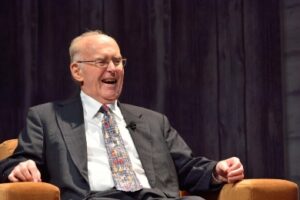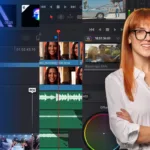Intel celebrates the semi-centennial of Moore’s Law with events highlighting the work of the Gordon and Betty Moore Foundation. Moore says he’s been surprised by how well his prediction has held up over the years, but he’s disappointed the US seems to be losing interest in investing in scientific research.
Moore’s Law turned 50 in April, 2015 and Intel has been celebrating by helping further the work of the Gordon and Betty Moore Foundation. It’s the least they can do. Moore’s Law, which states that the number of transistors in a dense integrated circuit will double every two years, has been very very good to Intel. Research firm IHS estimates that over $3 trillion in incremental GDP has been created over the last 20 years as a result of Moore’s Law.

Intel co-founder Gordon Moore made the prediction in an article for Electronics Magazine to explain how the technology industry could grow on a base of increasingly powerful and affordable semiconductors. Since then, Moore’s Law has become a self-fulfilling prophecy. The semiconductor industry uses Moore’s Law to set development goals to gauge its progress.
Gordon Moore and his wife Betty used their fortune to create the Gordon and Betty Moore Foundation, which supports work on conservation, healthcare, and science. The foundation reflects their love of the outdoors, Gordon’s interest in scientific exploration, and Betty’s commitment to patient care that grew out of her experiences as both a patient and a caregiver for her family members. Moore says the foundation reflects the family’s current interests but he can see it changing with changing generations, new technology, and shifting cultural concerns.
At an event held at the San Francisco Exploratorium, Moore was interviewed by author, economist, and New York Times reporter Tom Friedman. Friedman tried to pry a few more predictions from Moore who resisted saying, “one thing I’ve learned is once you’ve made a successful prediction, avoid making another one.” However, Moore did see that his law would lead to cheap and plentiful semiconductors which in turn would enable a wide range of computing devices for everyone including the Internet of Things, smart cars, and connected healthcare.
One thing he didn’t see coming was the Internet as it has evolved today to enable applications like Google Earth, “I could not have imagined something like that coming out,” he said, “let alone being free.” Moore says he’s really impressed with what software developers have been able to do and with work some of his grand kids are doing in robotics.
Moore is surprised as anyone else that his prediction has held true for so long. In his original article, Moore had said that the exponential increase of computer power was good for about ten years. He told Friedman, “Oh, I’m amazed,” he said, noting that his 10-year prediction meant “going from 60 elements on an integrated circuit to 60,000 – a thousandfold extrapolation over 10 years. I thought that was pretty wild.” However, he did admit that ultimately Moore’s Law will break. “No exponential like that can go on forever,” he said. He also said, though, that as Moore’s Law encountered barriers scientists figured out ways around them. That’s the drive, Moore hopes to see continue.
Moore told Friedman that he is disappointed that investment in scientific research has decreased in the U.S. The events around Moore’s Law were designed to help raise awareness about the importance of investing for the future. Moore told Friedman, that it takes a long time commitment to research to make something like Moore’s Law possible.
After Moore’s interview with Friedman, Harvey Fineberg, president of the Gordon and Betty Moore Foundation took the stage to underline the need for advanced research. He said that according to an MIT report entitled “The Future Postponed: Why Declining Investment in Basic Research Threatens a U.S. Innovation Deficit,” America is at risk of losing the lead in super-computing, cybersecurity, space exploration, energy and healthcare.
A video of the Friedman and Moore Interview is available on Intel’s website. The site also includes more videos of Gordon Moore and also analysts, Rob Enderle, Bob O’Donnell, Jon Peddie, and Dan Hutcheson. Finally, Friedman offers his take in a piece for the New York Times.





